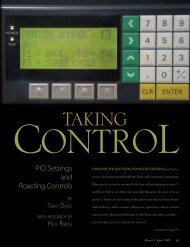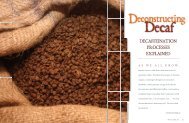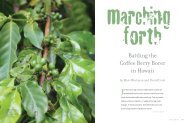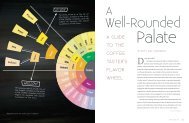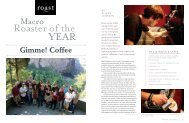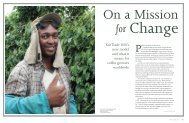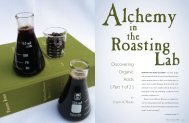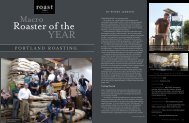How to Set Up an In-House Coffee Lab for QC and Training
How to Set Up an In-House Coffee Lab for QC and Training
How to Set Up an In-House Coffee Lab for QC and Training
Create successful ePaper yourself
Turn your PDF publications into a flip-book with our unique Google optimized e-Paper software.
<strong>Lab</strong><br />
Report<br />
<strong>How</strong> <strong>to</strong> <strong>Set</strong> <strong>Up</strong> <strong>an</strong><br />
<strong>In</strong>-<strong>House</strong> <strong>Coffee</strong> <strong>Lab</strong><br />
<strong>for</strong> <strong>QC</strong> <strong>an</strong>d <strong>Training</strong><br />
by<br />
Katie<br />
Gilmer<br />
coffee lab should be the crown jewel of a roaster’s<br />
A business. It’s a special room where roasters c<strong>an</strong> enjoy<br />
the sensory side of their operations while also validating<br />
<strong>an</strong>d rein<strong>for</strong>cing quality claims. Roasters use a lab not only<br />
<strong>for</strong> purchasing decisions <strong>an</strong>d sample evaluation, but also <strong>for</strong><br />
confirming that roasting operations are per<strong>for</strong>ming as they<br />
should. The lab is a place <strong>to</strong> experiment with grind <strong>an</strong>alysis,<br />
brewing techniques, roast level <strong>an</strong>d blending—<strong>an</strong>d <strong>to</strong> train<br />
staff in these areas <strong>an</strong>d more. Some labs also serve as a place<br />
<strong>to</strong> educate cus<strong>to</strong>mers <strong>an</strong>d demonstrate just how import<strong>an</strong>t<br />
quality is <strong>to</strong> your business.<br />
With so m<strong>an</strong>y uses, building or upgrading a lab c<strong>an</strong> be a<br />
daunting task. But upgrades c<strong>an</strong> be undertaken one by one<br />
as time <strong>an</strong>d budgets allow. If a roasting business pl<strong>an</strong>s its<br />
coffee lab in adv<strong>an</strong>ce, it c<strong>an</strong> build <strong>an</strong>d equip the lab <strong>to</strong> be<br />
useful <strong>for</strong> m<strong>an</strong>y years.<br />
continued on page 72<br />
70 roast May | June 2011 71
<strong>Lab</strong> Report: <strong>How</strong> <strong>to</strong> Build <strong>an</strong> <strong>In</strong>-<strong>House</strong> <strong>Coffee</strong> <strong>Lab</strong> <strong>for</strong> <strong>QC</strong> <strong>an</strong>d <strong>Training</strong> (continued)<br />
Why build a lab?<br />
A coffee lab is a safe haven <strong>for</strong> a roaster <strong>to</strong> make buying<br />
decisions without distraction. Just as a scientist measures <strong>an</strong>d<br />
experiments using the scientific method, coffee professionals<br />
should hold themselves <strong>to</strong> the highest st<strong>an</strong>dards of quality <strong>an</strong>d<br />
consistency when evaluating coffee. A lab is a space <strong>for</strong> roasters<br />
<strong>to</strong> take ownership of their inner “Type A” personality <strong>an</strong>d<br />
remain firm <strong>to</strong> st<strong>an</strong>dards <strong>an</strong>d rules. A roaster needs <strong>to</strong> be able <strong>to</strong><br />
make consistent decisions from year <strong>to</strong> year, <strong>an</strong>d using cupping<br />
pro<strong>to</strong>cols <strong>an</strong>d the scientific method will reduce variables.<br />
Maybe a roaster gets a report from <strong>an</strong> importer that a<br />
certain coffee has intense acidity; the roaster needs <strong>to</strong> try it <strong>for</strong><br />
herself, roasted at her altitude <strong>an</strong>d climate, using her specific<br />
profile <strong>an</strong>d her water. Getting <strong>an</strong> accurate sense of how the<br />
coffee per<strong>for</strong>ms in the roaster’s unique environment <strong>an</strong>d in the<br />
roaster’s blends is key <strong>for</strong> purchasing decisions.<br />
But maintaining a lab does not just benefit a roaster’s<br />
business. Mike Strumpf, who has m<strong>an</strong>aged quality control <strong>for</strong><br />
a number of coffee roasters in the United States, stresses a lab’s<br />
import<strong>an</strong>ce. “I think it’s all about fairness,” he says. “When<br />
you make contracts that have quality bonuses attached <strong>to</strong> them,<br />
you need <strong>to</strong> make <strong>an</strong> accurate assessment so you don’t hurt a<br />
farmer’s livelihood. If you don’t cup in a good lab, then your<br />
scores won’t be valid.”<br />
Furthermore, having a trustworthy lab will help roasters<br />
share quality st<strong>an</strong>dards with other coffee professionals<br />
worldwide. The Specialty <strong>Coffee</strong> Association of America’s<br />
<strong>Lab</strong>ora<strong>to</strong>ry Certification promotes consistent cupping st<strong>an</strong>dards <strong>an</strong>d<br />
the objective evaluation of coffee. The lab certification is needed <strong>for</strong><br />
holding Q Grader courses in a coffee lab, <strong>an</strong>d it addresses aspects<br />
such as room dimensions, lighting, ventilation, water specifications<br />
<strong>an</strong>d roast color identification technology. Even if a roaster isn’t<br />
prepared <strong>for</strong> official lab certification, the SCAA’s list of requirements<br />
is a good guide <strong>for</strong> widely accepted lab st<strong>an</strong>dards (<strong>for</strong> more detail,<br />
visit the Professional Development section of the SCAA’s website,<br />
www.scaa.org).<br />
Positioning your lab<br />
Maintaining the <strong>for</strong>mal nature of a lab is import<strong>an</strong>t. The lab<br />
is a space <strong>to</strong> hold cuppings <strong>for</strong> buying decisions, <strong>an</strong>d const<strong>an</strong>t<br />
interruptions will sabotage <strong>an</strong> import<strong>an</strong>t cupping. Think first<br />
about the best location <strong>for</strong> the lab. A roasting business will need<br />
a dedicated place where employees c<strong>an</strong> install machines <strong>an</strong>d<br />
equipment. Is the space near your production roaster? Is it in your<br />
retail space? Is it in a spare room next <strong>to</strong> the bookkeeper’s office?<br />
Will the public be invited in<strong>to</strong> the lab? Is there adequate plumbing<br />
<strong>an</strong>d electricity available?<br />
When Charles Pat<strong>to</strong>n, owner of Bird Rock <strong>Coffee</strong> Roasters,<br />
launched his roastery in La Jolla, Calif., in 2002, he had a small<br />
lab in the room with his roaster <strong>an</strong>d packaging operations. Pat<strong>to</strong>n<br />
says the setup was problematic. “It’s hard <strong>to</strong> make buying decisions<br />
in the same room as production because of all the noise <strong>an</strong>d<br />
commotion,” he says. “We w<strong>an</strong>ted our roaster <strong>to</strong> be involved in<br />
buying decisions, but right as we were about <strong>to</strong> break the crust, he<br />
would have <strong>to</strong> go fix a problem with the machines.”<br />
When Pat<strong>to</strong>n exp<strong>an</strong>ded <strong>to</strong> the retail space next door, he <strong>to</strong>ok<br />
adv<strong>an</strong>tage of the extra room <strong>to</strong> create a new lab. “When we exp<strong>an</strong>ded<br />
next door, we built a little room specifically <strong>for</strong> cuppings,” he says.<br />
“We added a kids’ zone next <strong>to</strong> the cupping lab. We found we had<br />
a lot of moms coming in with their kids, <strong>an</strong>d we needed <strong>to</strong> contain<br />
them. It really helped us accommodate more people <strong>an</strong>d grow<br />
business.” The lab is divided from the kids’ zone, but moms c<strong>an</strong> peek<br />
in at lab activity through a cu<strong>to</strong>ut in the wall.<br />
Bird Rock’s lab is open <strong>to</strong> the public, but Pat<strong>to</strong>n schedules the<br />
most import<strong>an</strong>t cuppings after hours. When he needs the undivided<br />
attention of his staff, it’s best <strong>to</strong> eliminate the possibility <strong>for</strong><br />
interruptions, he says.<br />
If a roasting business does not choose <strong>to</strong> hold public cuppings,<br />
continued on page 74<br />
72 roast May | June 2011 73
<strong>Lab</strong> Report: <strong>How</strong> <strong>to</strong> Build <strong>an</strong> <strong>In</strong>-<strong>House</strong> <strong>Coffee</strong> <strong>Lab</strong> <strong>for</strong> <strong>QC</strong> <strong>an</strong>d <strong>Training</strong> (continued)<br />
the business c<strong>an</strong> still hold them where the public c<strong>an</strong> watch.<br />
Cuppings are a fairly new intrigue <strong>for</strong> public consumption, so<br />
cus<strong>to</strong>mers will enjoy seeing this window in<strong>to</strong> the coffee buyer’s<br />
world.<br />
If the coffee lab will be constructed in a shared workspace, build<br />
walls or a barrier around it <strong>to</strong> block distracting noise or smells that<br />
could affect cuppers’ focus. <strong>In</strong>stall windows or a sliding glass door so<br />
others c<strong>an</strong> see when lab occup<strong>an</strong>ts should be left alone (<strong>an</strong>d so those<br />
working in the lab c<strong>an</strong> check on the situation outside the room).<br />
Think about all the functions of a lab—cupping, experimenting <strong>an</strong>d<br />
testing, as well as training <strong>for</strong> both employees <strong>an</strong>d cus<strong>to</strong>mers. If the<br />
roasting business c<strong>an</strong>not dedicate several separate spaces <strong>to</strong> the lab,<br />
take that in<strong>to</strong> consideration when pl<strong>an</strong>ning the size of the lab.<br />
An innovative idea coming from origin—where coffee<br />
professionals have become expert at devising economical solutions—<br />
is constructing a mobile lab. The Divisoria Cooperative in Tingo<br />
Maria, Peru, dispatches two mobile units <strong>to</strong> the most remote<br />
communities. The members c<strong>an</strong>’t often make the trek <strong>to</strong> the co-op<br />
offices <strong>to</strong> taste their own coffee, so the co-op brings the service <strong>to</strong><br />
them. Divisoria Quality Control M<strong>an</strong>ager Juli<strong>an</strong> Aucca built a lab<br />
composed of a small electric roaster, grinder, parchment dehuller<br />
<strong>an</strong>d folding table. He s<strong>to</strong>cked it with cups <strong>an</strong>d spoons, <strong>an</strong>d s<strong>to</strong>red it<br />
in a portable cupboard. The whole unit fits in the back of a pickup<br />
truck.<br />
While a roaster might use a mobile lab <strong>for</strong> cus<strong>to</strong>mer visits,<br />
Divisoria uses it as a way <strong>to</strong> identify where problems are happening<br />
on the farm level. “The mobile lab allows us <strong>to</strong> create a culture<br />
of quality,” Aucca says. “It gives our producers <strong>an</strong>other resource<br />
<strong>to</strong> know what a good coffee tastes like <strong>an</strong>d identify <strong>an</strong>y quality<br />
problems be<strong>for</strong>e they get serious.”<br />
Roasters should consider the return on investment of a mobile<br />
lab. Will it be worth the cost, or is <strong>an</strong> in-house lab sufficient?<br />
Whether mobile or stationary, public or private, find the solution<br />
that works best <strong>for</strong> the comp<strong>an</strong>y’s location <strong>an</strong>d business. First <strong>an</strong>d<br />
<strong>for</strong>emost, the goal is <strong>to</strong> evaluate coffee.<br />
Building your lab<br />
Whether a roasting business constructs a lab from scratch or<br />
sets it up in a preexisting space, there are a few considerations<br />
<strong>to</strong> think about. Tables <strong>an</strong>d s<strong>to</strong>rage areas, along with water <strong>an</strong>d<br />
power sources, need <strong>to</strong> be addressed from the start. Is the business<br />
thinking of having sit-down cuppings or st<strong>an</strong>ding cuppings? If<br />
st<strong>an</strong>ding, the lab will need a table that is high enough so cuppers’<br />
backs don’t hurt from bending over but low enough <strong>for</strong> the shorter<br />
cuppers. The table should have at least two feet of clear<strong>an</strong>ce on all<br />
sides so cuppers c<strong>an</strong> move around it freely. If a wooden cupping<br />
table will be used, make sure <strong>to</strong> choose wood that is fragr<strong>an</strong>ce-free<br />
<strong>an</strong>d invest in a fragr<strong>an</strong>ce-free finish <strong>to</strong> protect the table from water<br />
damage. For public cuppings, roasters will need <strong>to</strong> provide furniture that<br />
is accessible <strong>for</strong> people with disabilities.<br />
Another useful piece of furniture <strong>for</strong> the lab is a cabinet or shelving<br />
unit <strong>for</strong> s<strong>to</strong>ring green coffee samples. Opaque plastic or metal c<strong>an</strong>isters<br />
stack easily <strong>an</strong>d block the green coffee from damage from outside light.<br />
<strong>How</strong> m<strong>an</strong>y people will be using the lab on <strong>an</strong> average day? If the coffee<br />
business pl<strong>an</strong>s <strong>to</strong> dedicate a team of three people <strong>to</strong> cup every production<br />
roast, the requirements <strong>for</strong> furniture <strong>an</strong>d counter<strong>to</strong>p space will be much<br />
greater th<strong>an</strong> the requirements <strong>for</strong> a lab <strong>for</strong> a solo green buyer who is<br />
evaluating the occasional offer sample. Think about how m<strong>an</strong>y coffees the<br />
roasting business will evaluate on <strong>an</strong> hourly basis. If the comp<strong>an</strong>y is using<br />
SCAA st<strong>an</strong>dards, it will need five cups <strong>for</strong> each coffee. Cup needs add up<br />
quickly at that rate. Pl<strong>an</strong>ning the cupping frequency will also help roasters<br />
determine their hot-water requirements. It’s essential <strong>to</strong> have a sufficient<br />
supply at the right temperature.<br />
The water situation in a lab requires adv<strong>an</strong>ce pl<strong>an</strong>ning. If a roasting<br />
comp<strong>an</strong>y intends <strong>to</strong> pipe in water, make sure a filtration system is in<br />
place. At Bird Rock, Pat<strong>to</strong>n chose <strong>to</strong> use bottled water <strong>for</strong> his lab instead of<br />
going through the plumbing hassle.<br />
Will the business be cupping coffees every day, multiple times per<br />
day? A hot-water <strong>to</strong>wer will make the process much more efficient. Kim<br />
Bullock, who m<strong>an</strong>ages sustainability <strong>an</strong>d producer relations <strong>for</strong> Counter<br />
Culture <strong>Coffee</strong> <strong>an</strong>d is a member of the comp<strong>an</strong>y’s quality-control team,<br />
has this piece of advice: “Pl<strong>an</strong> <strong>for</strong> a lot of power—either a 220-volt, 30-amp<br />
continued on page 76<br />
Equipment<br />
Essentials<br />
3Sample roaster<br />
3Grinder<br />
3Digital scale<br />
3Electric water<br />
kettles<br />
3Hot-water<br />
<strong>to</strong>wer<br />
3Cups or glasses<br />
3Spoons<br />
3Timer<br />
3Scoring sheets<br />
3Digital<br />
thermometer<br />
3Humidity meter<br />
74 roast May | June 2011 75
<strong>Lab</strong> Report (continued)<br />
circuit where you c<strong>an</strong> hook up a hot water <strong>to</strong>wer or enough<br />
110 outlets on dedicated circuits so you c<strong>an</strong> plug in a bunch of<br />
water kettles.” Water kettles are the least expensive way <strong>to</strong> boil<br />
water <strong>for</strong> cuppings, but they are infamous <strong>for</strong> tripping circuit<br />
breakers.<br />
Lighting is <strong>an</strong>other crucial consideration <strong>for</strong> a coffee lab.<br />
Nature is the best light source, but natural light c<strong>an</strong> be hard<br />
<strong>to</strong> come by in the winter. If natural light is not <strong>an</strong> option or<br />
the comp<strong>an</strong>y would like <strong>to</strong> supplement it, be sure <strong>to</strong> choose<br />
full-spectrum light bulbs. They emit a cle<strong>an</strong>, white light that<br />
emulates daylight. Avoid yellow-<strong>to</strong>ned light because it will<br />
ch<strong>an</strong>ge the way the coffee looks. For sample roasters with more<br />
th<strong>an</strong> one barrel, make sure that the same amount of light falls<br />
over each barrel. A long tube or track lighting will ensure that<br />
the light, <strong>an</strong>d consequently the sample roasting, is consistent<br />
from barrel <strong>to</strong> barrel. Some labs may install red light bulbs or red<br />
light covers <strong>for</strong> tri<strong>an</strong>gulation tests <strong>to</strong> homogenize the color of<br />
the coffee, both as grinds <strong>an</strong>d brewed. Roasters c<strong>an</strong> experiment<br />
with red light, but they c<strong>an</strong> also try turning off their normal<br />
lights <strong>an</strong>d per<strong>for</strong>ming a color test with only ambient light from<br />
outside the lab. Roasters may find the red lights still emit <strong>to</strong>o<br />
much brightness <strong>an</strong>d that low light is a better alternative <strong>for</strong><br />
those special exercises.<br />
Air circulation <strong>an</strong>d temperature are import<strong>an</strong>t<br />
considerations <strong>for</strong> the lab, as well. An HVAC (heating,<br />
ventilation <strong>an</strong>d air conditioning) system keeps the lab at a<br />
com<strong>for</strong>table temperature. Carefully pl<strong>an</strong> the vent locations<br />
<strong>to</strong> prevent <strong>an</strong> air vent from blowing on half of your cupping<br />
table but not the other, resulting in unevenly cooled cups. <strong>In</strong><br />
addition, the airflow must not be so strong that it disturbs the<br />
coffee’s aroma during cupping exercises. A programmable HVAC<br />
system also helps <strong>to</strong> maintain a com<strong>for</strong>table room temperature<br />
<strong>an</strong>d a consistent relative humidity inside the lab.<br />
An adv<strong>an</strong>ced lab feature is <strong>an</strong> air-pressure stabilizer. Cle<strong>an</strong><br />
rooms, hospitals, <strong>an</strong>d labs <strong>for</strong> pharmaceutical or electronics<br />
m<strong>an</strong>ufacturing frequently use pressure stabilization <strong>to</strong> maintain<br />
a sterile environment. <strong>In</strong> a hospital, a patient with a contagious<br />
illness will be put in a pressure-negative room, ensuring that<br />
when the patient’s door is opened, air from the hallway flows<br />
in<strong>to</strong> the room, keeping the illness inside the room. Conversely,<br />
air will flow out of a pressure-positive room. For a pressurepositive<br />
coffee lab, this me<strong>an</strong>s that outside aromas are kept<br />
out of the lab. Pressure stabilizers control room pressure<br />
differentials through the ventilation system; <strong>to</strong> create positive<br />
pressure, more air is mech<strong>an</strong>ically supplied <strong>to</strong> a room th<strong>an</strong> is<br />
mech<strong>an</strong>ically exhausted.<br />
Roasting businesses should stress that the lab really is a<br />
labora<strong>to</strong>ry—a place <strong>to</strong> learn <strong>an</strong>d experiment—by displaying<br />
educational posters. A green-coffee-defect chart is practical <strong>for</strong><br />
decoding a funky-looking be<strong>an</strong>. The SCAA’s flavor wheel is a<br />
good source <strong>for</strong> cupping vocabulary. And maps are a must-have<br />
<strong>for</strong> pointing out sample origins. If extra space is available in<br />
the lab, s<strong>to</strong>ck a shelf with coffee reference books. A computer<br />
or tablet in the lab is useful <strong>for</strong> showing cus<strong>to</strong>mers pho<strong>to</strong>s <strong>an</strong>d<br />
video from coffee origins.<br />
Le Nez du Café, a kit of 36 aroma vials representing the<br />
scents found in coffee, is <strong>an</strong>other good addition <strong>to</strong> the lab. If<br />
inexperienced cuppers<br />
find it difficult <strong>to</strong> discern<br />
differences between coffees,<br />
have them practice with Le<br />
Nez du Café. This kit should<br />
be used <strong>for</strong> training but<br />
shouldn’t be used in a coffee<br />
lab during cupping, as the<br />
aromas may taint a quality<br />
evaluation.<br />
<strong>Lab</strong> essentials<br />
Building a coffee lab c<strong>an</strong><br />
be <strong>an</strong> expensive endeavor.<br />
Outfitting a lab <strong>to</strong> its fullest<br />
c<strong>an</strong> easily cost more th<strong>an</strong><br />
$10,000. <strong>How</strong>ever, sticking <strong>to</strong> the basics c<strong>an</strong> cost as little as<br />
$2,000. There are a few essentials that every lab needs: a sample<br />
roaster, a grinder, cups, spoons, a digital scale, a timer, <strong>an</strong>d<br />
water kettles or a hot-water <strong>to</strong>wer. A sink, garbage disposal <strong>an</strong>d<br />
dishwasher will make cle<strong>an</strong>up much faster.<br />
Unless a coffee business c<strong>an</strong> roast small sample batches with<br />
a production roaster, the business will need <strong>to</strong> procure a sample<br />
roaster <strong>to</strong> save energy <strong>an</strong>d roast those small green samples.<br />
Whether a roasting business invests in a <strong>to</strong>p-of-the-line model<br />
or a modest one, it’s import<strong>an</strong>t <strong>to</strong> measure temperature <strong>an</strong>d<br />
other variables accurately <strong>to</strong> produce the same results every<br />
time. According <strong>to</strong> Bullock of Counter Culture, “The key [<strong>to</strong><br />
sample roasting] is consistency. A machine purchased in the<br />
local market might not have the greatest airflow, but <strong>for</strong> sample<br />
roasters it’s more about being consistent from roast <strong>to</strong> roast.”<br />
Even with a basic sample roaster, a coffee business c<strong>an</strong><br />
achieve consistent samples by underst<strong>an</strong>ding the principles<br />
of sample roasting <strong>an</strong>d having a well-trained person at the<br />
helm. Leave a sample of the comp<strong>an</strong>y’s ideal roast level next <strong>to</strong><br />
your roaster <strong>for</strong> comparison. Of course, a fire extinguisher is a<br />
necessity in a lab with a roaster. Make sure that employees are<br />
familiar with the building’s fire code in case law requires a more<br />
sophisticated fire-suppression system.<br />
It’s ideal <strong>to</strong> dedicate a burr grinder <strong>for</strong> lab use only rather<br />
th<strong>an</strong> sharing a production grinder. Devote the grinder solely<br />
<strong>to</strong> cupping <strong>an</strong>d training purposes, <strong>an</strong>d be sure <strong>to</strong> cle<strong>an</strong> it <strong>an</strong>d<br />
replace the burrs regularly. A quality grinder ensures consistency<br />
in the grind’s particle size, which will enh<strong>an</strong>ce coffee evaluation.<br />
Ceramic bowls or rocks glasses are most commonly used <strong>for</strong><br />
cupping. If the lab is using new cups, take measurements so<br />
employees c<strong>an</strong> cup with the correct water-<strong>to</strong>-coffee ratio. A<br />
digital thermometer is useful <strong>to</strong> have on h<strong>an</strong>d <strong>for</strong> measuring<br />
water temperature.<br />
A humidity meter is also h<strong>an</strong>dy in a lab, as it will help<br />
roasters know what <strong>to</strong> expect when sample roasting. It’s<br />
import<strong>an</strong>t <strong>to</strong> test samples’ humidity be<strong>for</strong>e buying—green be<strong>an</strong><br />
humidity lower th<strong>an</strong> 10 percent or higher th<strong>an</strong> 12 percent should<br />
throw up a red flag. An Agtron machine or color tiles are also<br />
continued on page 78<br />
76 roast May | June 2011 77
<strong>Lab</strong> Report: <strong>How</strong> <strong>to</strong> Build <strong>an</strong> <strong>In</strong>-<strong>House</strong> <strong>Coffee</strong> <strong>Lab</strong> <strong>for</strong> <strong>QC</strong> <strong>an</strong>d <strong>Training</strong> (continued)<br />
helpful additions <strong>to</strong> a lab <strong>for</strong> <strong>an</strong>alyzing the roast level of production<br />
roasts.<br />
Strumpf also suggests procuring a <strong>to</strong>p-of-the-line scale because<br />
the higher price will pay off over the years. He recommends a Class<br />
3 scale. “A Class 3 scale is legal <strong>for</strong> trade <strong>an</strong>d c<strong>an</strong> be recalibrated,”<br />
Strumpf notes. “Keep your scales on a yearly calibration schedule.”<br />
Calibration is a <strong>to</strong>p lab concern <strong>for</strong> Strumpf. “This is something<br />
a lot of labs overlook—getting your grinder, moisture meter <strong>an</strong>d<br />
scale on a calibration schedule,” he says. Roasters c<strong>an</strong> do some of<br />
this calibration themselves. Ask the moisture meter comp<strong>an</strong>y <strong>to</strong><br />
send a sample (usually barley) with a fixed moisture level. Then,<br />
tare the machine using this sample. To calibrate the grinder, do a<br />
grind <strong>an</strong>alysis if the comp<strong>an</strong>y has the available equipment, or send<br />
samples <strong>to</strong> comp<strong>an</strong>ies who will per<strong>for</strong>m the <strong>an</strong>alysis <strong>an</strong>d share the<br />
results.<br />
Strumpf’s other must-have <strong>to</strong>ol <strong>for</strong> the lab is a commercial<br />
s<strong>an</strong>itizer, as normal dishwashers take <strong>to</strong>o long. With a s<strong>an</strong>itizer,<br />
“a cycle is four minutes,” says Strumpf. “You c<strong>an</strong> put 30 cups on a<br />
tray. So with two trays, you c<strong>an</strong> wash 60 cups at once.” If roasters<br />
<strong>an</strong>d buyers are cupping often, a s<strong>an</strong>itizer saves a subst<strong>an</strong>tial amount<br />
of time. S<strong>an</strong>itizers work with either chemical cle<strong>an</strong>sers or with hot<br />
water. If a roasting business chooses <strong>to</strong> use a cle<strong>an</strong>ser, experiment<br />
with different types <strong>to</strong> ensure they are fragr<strong>an</strong>ce <strong>an</strong>d residue free.<br />
If the roastery will be holding public cuppings, the business<br />
may w<strong>an</strong>t <strong>to</strong> have scoring sheets on h<strong>an</strong>d. Counter Culture <strong>Coffee</strong><br />
developed its own internal scoring sheet that best fits their<br />
comp<strong>an</strong>y’s needs, but the comp<strong>an</strong>y uses a modified <strong>for</strong>m <strong>for</strong><br />
outsiders. Bullock says, “For our public cuppings, we pared the <strong>for</strong>m<br />
down so it’s just the sensory categories <strong>an</strong>d space <strong>for</strong> notes but not<br />
space <strong>for</strong> scores.” It is useful <strong>to</strong> have different <strong>for</strong>ms on h<strong>an</strong>d, such<br />
as SCAA <strong>an</strong>d Cup of Excellence, <strong>to</strong> show <strong>to</strong> staff or <strong>an</strong>yone else who is<br />
interested in how they vary.<br />
Getting the most out of your lab<br />
Since you have put so much time <strong>an</strong>d money in<strong>to</strong> the coffee lab, it’s<br />
up <strong>to</strong> you <strong>to</strong> harness all of its potential. Use it as much as possible,<br />
<strong>an</strong>d use it wisely. If a roasting comp<strong>an</strong>y installs a pull-down<br />
screen <strong>an</strong>d projec<strong>to</strong>r, the lab c<strong>an</strong> be <strong>an</strong> ideal place <strong>to</strong> gather staff or<br />
cus<strong>to</strong>mers <strong>to</strong> show them presentations or videos. And, with some<br />
careful pl<strong>an</strong>ning, a lab c<strong>an</strong> serve as <strong>an</strong> office in a pinch.<br />
Of course, sharing the lab space me<strong>an</strong>s that there are a few rules<br />
that need <strong>to</strong> be adhered <strong>to</strong>. Keeping the lab cle<strong>an</strong> is a priority. Think<br />
of it as a sterile environment—you would never see stray powders or<br />
clutter in a chemistry lab. S<strong>to</strong>ck a cupboard with cle<strong>an</strong>ing supplies<br />
so they’re always on h<strong>an</strong>d. Make sure the machines receive regular<br />
cle<strong>an</strong>ing <strong>an</strong>d mainten<strong>an</strong>ce.<br />
Cle<strong>an</strong>liness is just one of the elements of a fine-tuned lab.<br />
Another requirement is a set of lab rules. A Bill of Rights <strong>for</strong> the<br />
lab should express your wishes on paper <strong>an</strong>d be posted on the wall.<br />
Strumpf says his No. 1 rule is “no smelly perfumes or deodor<strong>an</strong>ts.”<br />
Other good rules: no cell phones inside the lab, no talking during<br />
cuppings, <strong>an</strong>d no outside food or beverages in the lab area. If the lab<br />
will be used in a number of different ways, it might be helpful <strong>to</strong><br />
post a schedule. See the sidebar on this page <strong>for</strong> more suggestions <strong>for</strong><br />
lab rules.<br />
TOP 10<br />
RULES FOR<br />
COFFEE LABS<br />
1<br />
2<br />
3<br />
4<br />
5<br />
6<br />
7<br />
8<br />
9<br />
10<br />
No perfumes or colognes.<br />
No outside food or beverages.<br />
No interrupting the cuppers (talking,<br />
music or questions) during the<br />
process.<br />
No cell phones/texting in the lab.<br />
Office phones should have ringers off<br />
during testing.<br />
No flavored coffees.<br />
Only unbiased evaluations.<br />
Equipment is <strong>to</strong> be maintained in<br />
“new” condition at all times.<br />
Do not roast samples during the<br />
cupping process.<br />
Cup coffees light <strong>to</strong> dark roast, delicate<br />
<strong>to</strong> intense.<br />
No clutter. Keep activities like shipping<br />
<strong>an</strong>d packaging in other areas.<br />
With org<strong>an</strong>ization <strong>an</strong>d rules, as well as lab pro<strong>to</strong>col,<br />
consistency is the goal. Be consistent, even if the machines<br />
in the lab are not <strong>to</strong>p of the line. This consistency in processes<br />
will give you the most accurate results possible. Adhering <strong>to</strong> a<br />
strict quality-control regime will pay off when it comes time<br />
<strong>to</strong> upgrade equipment. For ratios, water temperature, <strong>an</strong>d<br />
other measurable vari<strong>an</strong>ts, defer <strong>to</strong> industry st<strong>an</strong>dards when<br />
in doubt.<br />
Once roasters have decided on the uses of the lab, sourced<br />
the furniture <strong>an</strong>d equipment, <strong>an</strong>d established a code of<br />
conduct, the new coffee lab will serve m<strong>an</strong>y aspects of the<br />
business. Roasters will be able <strong>to</strong> make consistent <strong>an</strong>d fair<br />
business decisions while enjoying a space <strong>to</strong> make quality<br />
control all their own.<br />
Katie Gilmer is a relationship coffee m<strong>an</strong>ager <strong>for</strong> Sustainable<br />
Harvest <strong>Coffee</strong> Importers in Portl<strong>an</strong>d, Ore. A Q Grader, she works with<br />
Sustainable Harvest’s <strong>QC</strong> labs at origin <strong>to</strong> make sure they are calibrated.<br />
E-mail her at katie@sustainableharvest.com.<br />
78 roast May | June 2011 79



